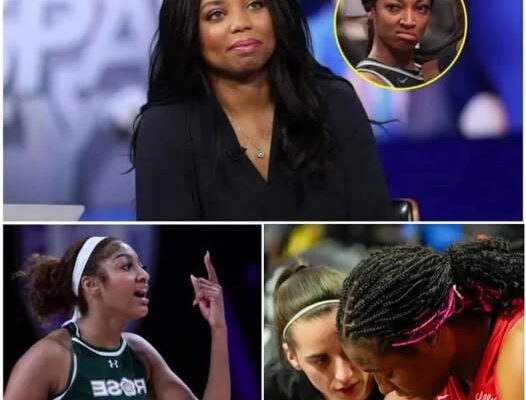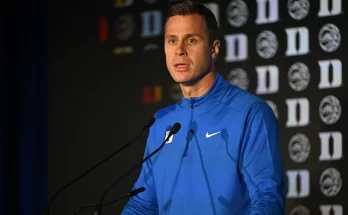“Angel Reese Is the Michael Jordan of the WNBA—Already Outshining Caitlin Clark!” is Jemele Hill’s audacious assertion.
Is this the trendiest basketball prediction of the year? Jemele, a sports analyst
Jemele Hill, the outspoken and often provocative sports journalist, has ignited a fresh firestorm in the basketball world with her audacious assertion: “Angel Reese is the Michael Jordan of the WNBA—Already Outshining Caitlin Clark!” In a sports media environment obsessed with hot takes and instant legacies, this statement stands as one of the boldest predictions of the year. It’s also a mirror to deeper tensions and narratives brewing within women’s basketball—a space that has been undergoing an electrifying transformation over the past two seasons.
To understand the gravity of Hill’s comparison, one must first consider the weight carried by the name Michael Jordan. Jordan isn’t just the greatest basketball player of all time in many fans’ eyes; he is an icon, a brand, and the very definition of athletic excellence. By placing Angel Reese in that same category—so early in her professional career—Hill is either seeing a trajectory few dare to envision or deliberately stoking the fire of an already inflamed discourse surrounding the WNBA’s newest and most polarizing stars.
Angel Reese’s impact on the league so far has been undeniable. From her arrival, she brought more than just basketball skills; she brought cultural capital, personality, and a chip on her shoulder. Known as the “Bayou Barbie” during her collegiate days at LSU, Reese has leaned into a persona that mixes brash confidence with unapologetic authenticity. Her game—rebounding tenacity, rim protection, and physical post dominance—backs up her flair. She’s posted multiple double-doubles as a rookie, regularly outmuscling veteran forwards and proving her mettle on both ends of the court. Her ability to elevate her team’s energy, disrupt offenses, and control the paint has already shifted the dynamics of her squad, the Chicago Sky.
But is that enough to warrant the “Michael Jordan” moniker?
Jordan’s career wasn’t built on flash and early success alone. It was carved over time, through dominance, championships, MVPs, and iconic moments that transformed the NBA into a global phenomenon. For Reese, this comparison places an enormous and perhaps unfair burden on her shoulders. Yet Hill’s comparison may not be strictly about playstyle or resume. It might be rooted in cultural impact, charisma, and how Reese is challenging existing norms in women’s sports—much like Jordan once did for men’s.
Then there’s the other side of Hill’s quote: “Already outshining Caitlin Clark.” This part might be even more inflammatory.
Caitlin Clark, whose record-shattering college career at Iowa turned her into a national sensation, entered the WNBA with perhaps the most hype any rookie has ever had. Her deep shooting range, court vision, and scoring prowess made her must-watch TV. Clark was the main driver of record-breaking viewership numbers, packed arenas, and sold-out merchandise before she even played a professional game. Yet her transition to the WNBA has been anything but seamless. Early struggles with physicality, defensive schemes tailored to stop her, and chemistry issues with her Indiana Fever teammates have tempered expectations. Though she’s shown flashes of brilliance—like deep three-pointers and dazzling passes—her impact on the win column has been inconsistent.
In contrast, Angel Reese’s statistical steadiness and defensive intensity have made her a reliable presence. The metrics show that Reese is among the league’s top rebounders and is often key in crunch-time situations. Her presence helps her team in tangible, measurable ways that go beyond highlight reels. That said, comparing their contributions is a minefield of complexity, given that they play entirely different positions, fill different roles, and are part of very different team dynamics.
Yet what makes Hill’s prediction so striking is not just the comparison—it’s the cultural context. Reese and Clark are more than athletes. They are now symbols, sometimes unwillingly, of race, class, style, and the evolving culture of sports fandom. Clark, a white Midwestern shooter with an “old-school” game and quiet confidence, has attracted a fanbase that includes many who are new to women’s basketball. Reese, a bold, Black forward from Baltimore with a hip-hop sensibility and confrontational edge, represents a different segment of fans who see in her a voice that challenges the status quo.
This cultural tension exploded during their college matchups, particularly during the 2023 NCAA championship game, when Reese’s taunting gesture—mimicking Clark’s own “you can’t see me” move—was dissected, debated, and dissected again on every major platform. The media coverage often racialized the moment, painting Reese as “classless” while downplaying Clark’s similar antics. The dichotomy has stuck with both players in the pros, and it’s clear that Hill’s statement is more than just a basketball evaluation; it’s a cultural declaration.
So, is Jemele Hill’s take the trendiest basketball prediction of the year? In many ways, yes. It doesn’t just light up sports Twitter (or X, depending on your platform). It slices into ongoing debates about talent, media bias, race, and branding. It forces fans, analysts, and league stakeholders to consider how narratives are formed and who gets to be celebrated in women’s sports. The WNBA, long hungry for mainstream attention, is now navigating an environment where its rookies are household names and lightning rods for national discourse. Hill’s take feeds directly into this new ecosystem—where a viral statement can shape fan perception, drive ratings, and even influence All-Star votes.
But is it accurate?
That’s the tricky part. Reese has been superb, but she is far from the league’s best player. Her numbers, while impressive, do not place her above the likes of A’ja Wilson, Breanna Stewart, or Napheesa Collier. Clark, despite her rocky start, remains an offensive weapon capable of changing games with her shooting alone. One could argue that both are still finding their footing, and the idea that one is already “outshining” the other may be premature. It’s less about current performance and more about trajectory, perception, and influence.
There’s also the question of longevity. Michael Jordan didn’t just shine early—he maintained dominance for over a decade. For Reese to truly embody that legacy, she’ll need to evolve her game, stay healthy, win championships, and continue to be a force well beyond her rookie year. The same applies to Clark, who is already adjusting her game to the WNBA’s faster pace and defensive intensity. Both players could eventually become league cornerstones. Whether one “outshines” the other might depend more on context—teammates, coaching, injuries, and mental resilience—than raw talent alone.
Still, Jemele Hill’s framing of this narrative forces us to confront uncomfortable questions about who gets to be the face of the league. The WNBA, like any professional sports league, is driven by stars, but also by stories. Angel Reese’s story—a bold, Black woman thriving against the odds, embracing her roots, and standing firm in her identity—is compelling and timely. Comparing her to Michael Jordan isn’t just about gameplay; it’s about what she represents: a new kind of leadership, a new kind of charisma, and perhaps a new model for how the league markets its future.
On the flip side, reducing Clark to a mere foil undercuts her significance. She, too, is navigating immense pressure, intense scrutiny, and unfair expectations. Her grace under fire, willingness to take responsibility, and refusal to shy away from the challenge speak volumes about her character and potential. The Clark-Reese rivalry may well define the next decade of the WNBA, much like Magic vs. Bird or LeBron vs. KD did for the NBA.
In the end, Jemele Hill’s assertion might be exaggerated, even hyperbolic, but that’s partly the point. In a league desperate for attention, hot takes like this do more than stir debate—they generate visibility, passion, and dialogue. They invite fans to invest emotionally, to pick sides, and to engage in the sport beyond the box score. Whether Reese is the “Michael Jordan” of the WNBA or whether Clark is just getting started on her own GOAT trajectory, the truth is we’re witnessing a unique moment in sports history. Two young women, both under 25, are changing the narrative around what women’s basketball can be—and who it’s for.
So, is it the trendiest basketball prediction of the year? Undoubtedly. But more importantly, it’s a statement that forces us to look closer—not just at Angel Reese and Caitlin Clark, but at how we define greatness, how we measure impact, and what kind of stories we choose to elevate. Time will tell if Hill’s prophecy proves true. For now, it’s already doing what every great sports prediction should: sparking debate, challenging assumptions, and keeping the game alive long after the final buzzer.



